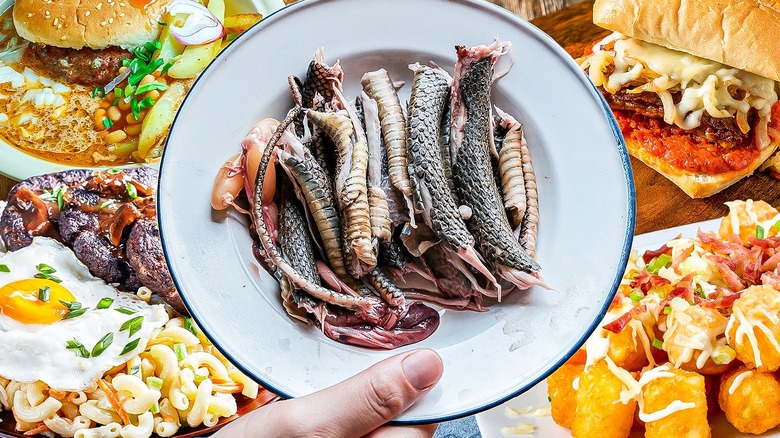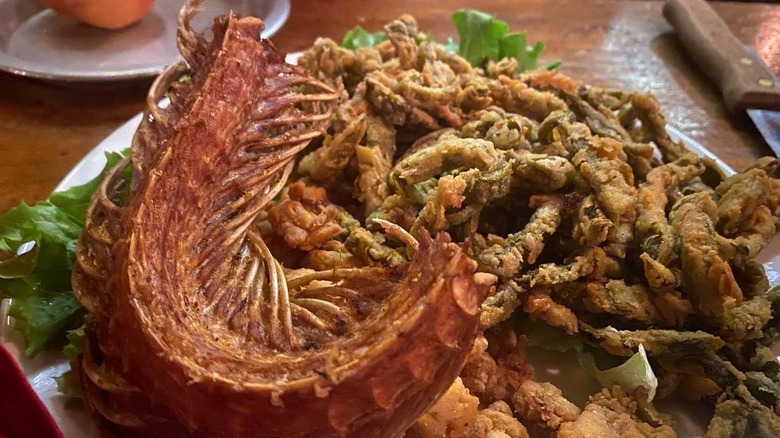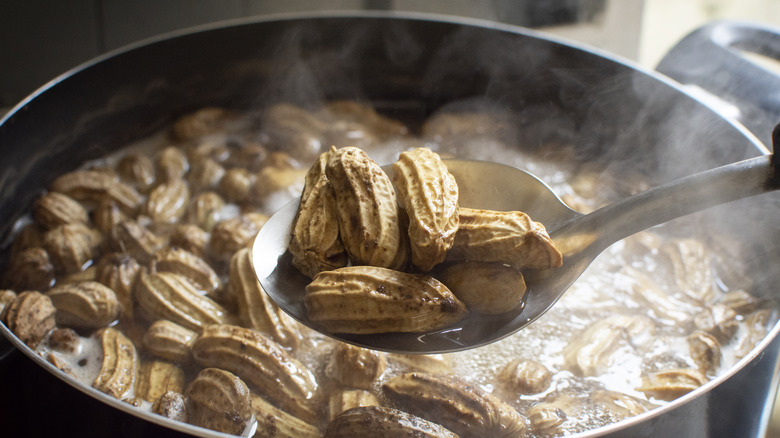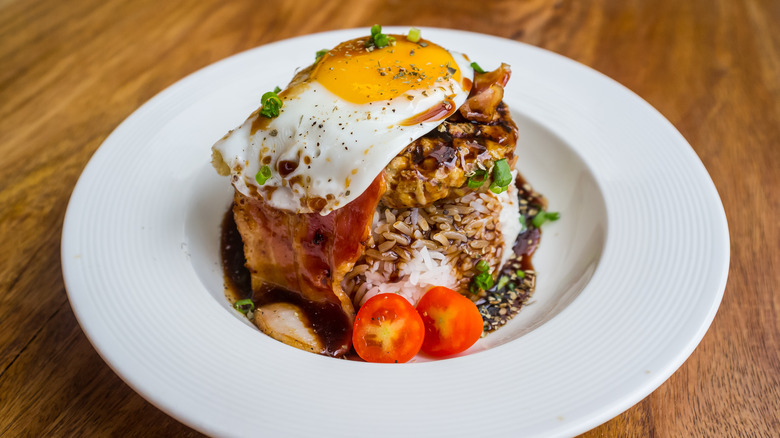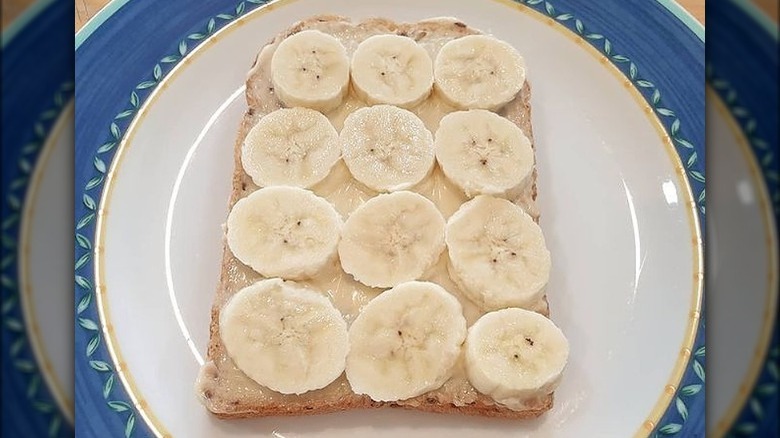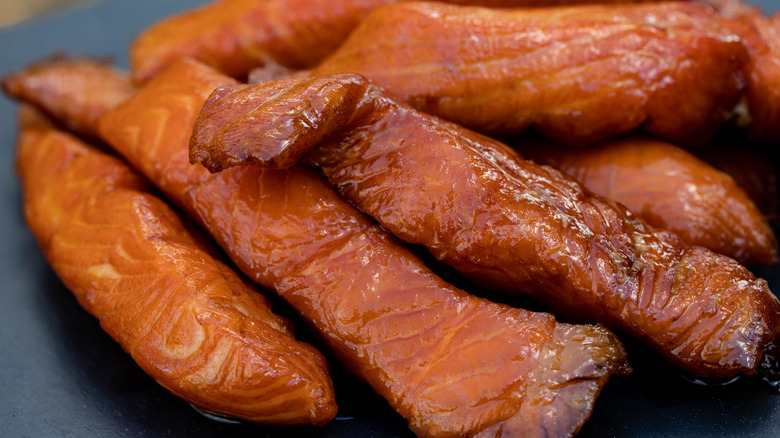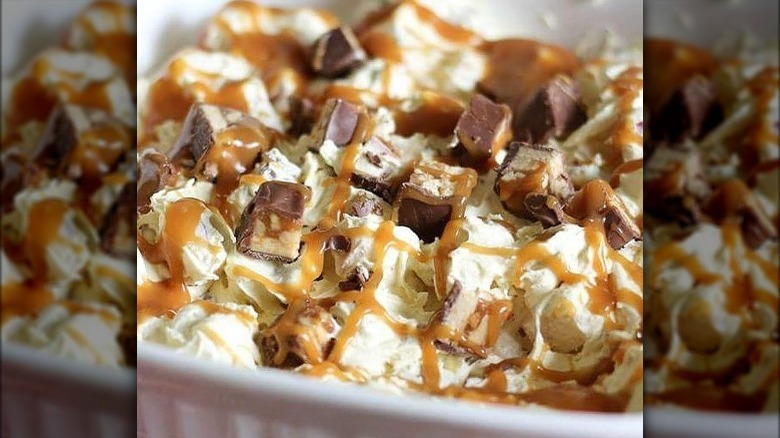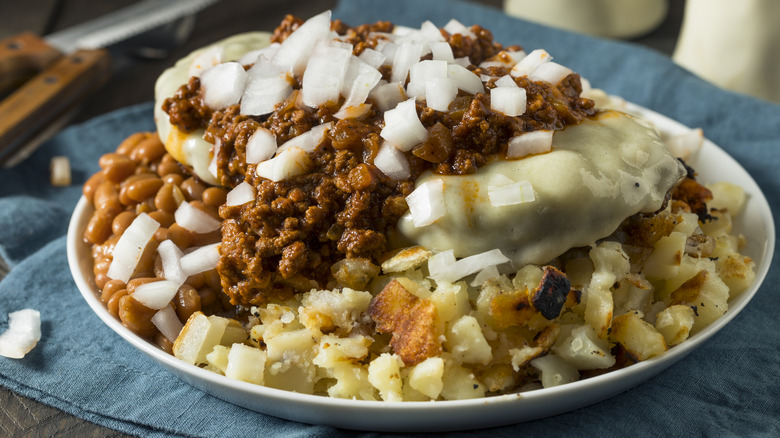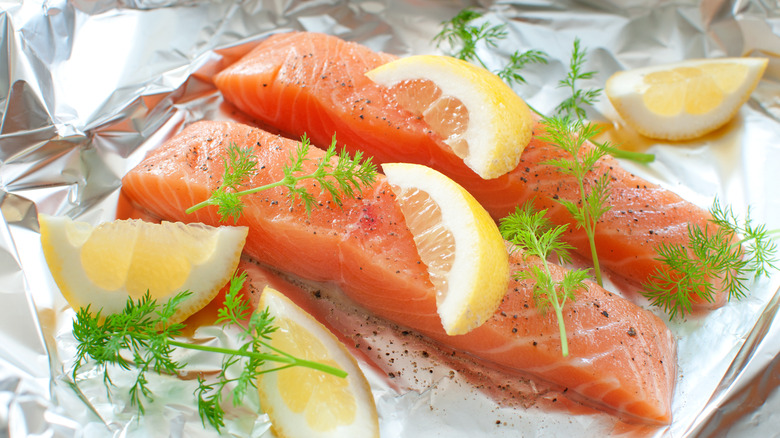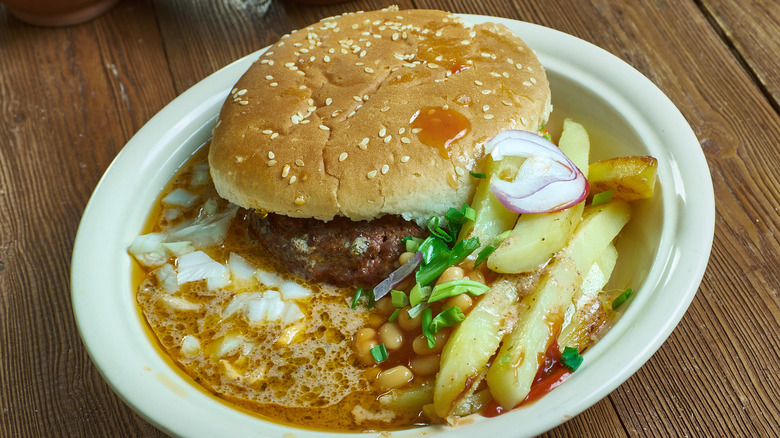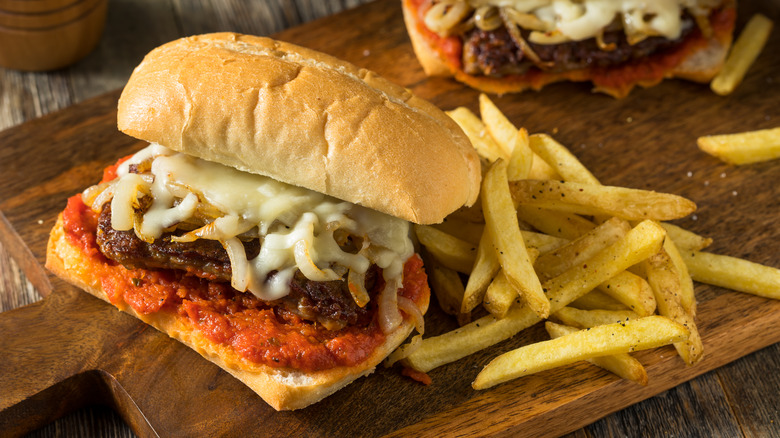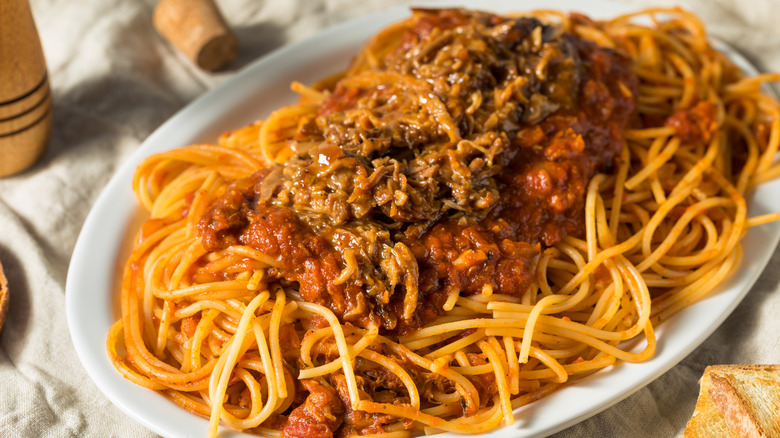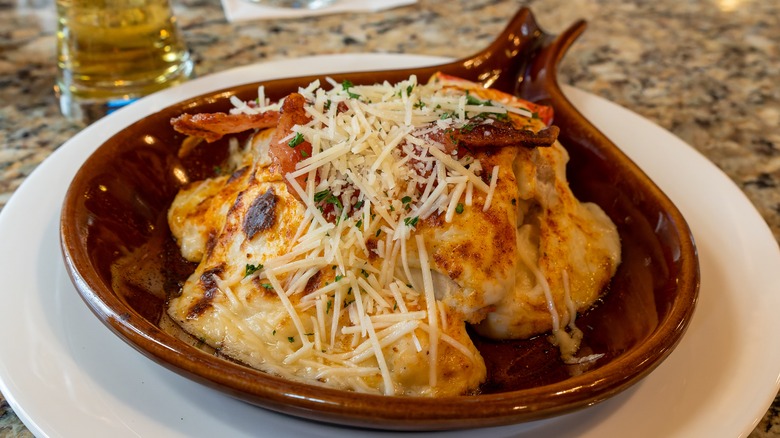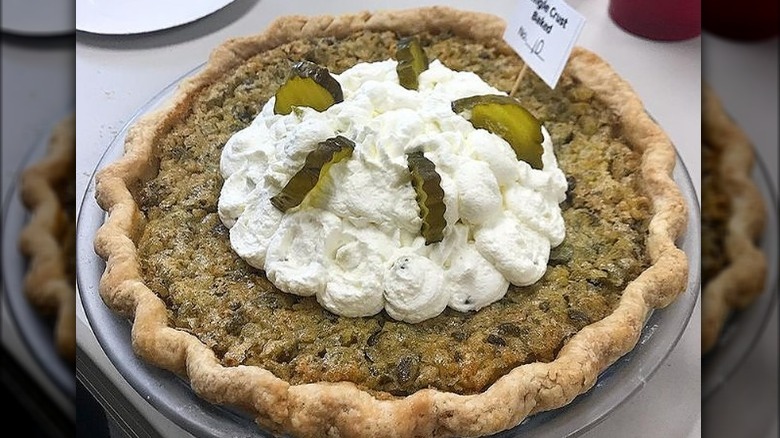13 Regional Foods Outsiders May Never Understand
No matter how well-traveled an eater may be, every region in the U.S. has unique food offerings that only insiders can truly appreciate. We're not talking about the recipes everyone wants to try. These dishes are idiosyncratic, whimsical, and difficult to palate if you aren't familiar with their heritage or ingredients. While some have become beloved hyperlocal flavors due to the availability of ingredients, others are inventions born of imagination and a sense of adventure. Whatever the origin, the mere mention of these items sparks a fire of recognition from anyone who's ever tasted them, for better or worse.
Those who haven't tried boiled peanuts from the South, loco moco from Hawaii, or cudighi from Michigan's Upper Peninsula may never understand the devotion inspired by treasured foods that need to be enjoyed in their original environment for maximum effect. Attempts to recreate the dish elsewhere won't do. We tracked down a menu of quirky foods created with an undeniable local accent, solely understood by eaters who occupy the terrain of origin. Step away from the regional specialties everyone should try and get a taste of the local treats only a native can love — if you can stomach it.
1. Rattlesnake
While you may not want to come across one of these fanged critters on a hiking trail, diners in the Southwest are at ease with finding rattlesnake listed on menus. There's even a record of an ancestral individual eating an entire raw rattlesnake. Sidestepping that sort of gross-out moment, desert dwellers often hunt their own rattlesnakes to cook at home.
No matter where it's prepared, the head is always removed to eliminate the danger of the snake's venom. There are also local regulations about hunting and transporting rattlesnakes beyond their home state, which can limit the prospect of finding the snake being served in areas outside of its natural habitats. That's good news for both the regional residents who love eating them and everyone else who doesn't.
As for flavor, the running joke is that rattlesnake, like many other unfamiliar meats, tastes like chicken. Actually, rattlesnake will usually taste like the prey the creature ate before it became food itself. Often, restaurant-served rattlesnake comes as fried chunks like chicken nuggets, and anything prepared this way will come out tasting like it used to cluck. No big surprise there.
2. Boiled Peanuts
Peanuts are a pretty perfect food without any prep needed. But Southerners have engaged in the tradition of boiling them for a great deal of their history. This is due to the African tradition of peanut boils brought to America by enslaved peoples when peanuts were first grown in the U.S. The briny boiling process helped to cook and flavor peanuts that couldn't be roasted due to their greenness. Later, peanuts were easily carried during the Civil War, boiled and salted by soldiers to preserve them for travel. A recipe for boiled peanuts first appeared in print in 1899, courtesy of vegetarian cookbook author Almeda Lambert.
In the 1920s, boiled peanuts were a popular snack sold in the South and quickly transformed from sustenance to a hallmark of Southern life. What may not be known by locals who enjoy boiled peanuts is that cooking these legumes elevates the antioxidant, vitamin, and mineral content. So while it might seem nothing more than a quaint and unusual holdover from the early days of the region, it's a stealthy way to up the nutritional value of an insider snack loved for generations.
3. Loco Moco
If you've traveled to the tropical paradise of Hawaii, you've likely encountered a dish known as loco moco. It's a standard on breakfast tables at restaurants on every island. This regional favorite is relatively new, having appeared at the Lincoln Grill in Hilo on the Big Island in 1949. The story goes that local teenagers requested a meat patty with gravy served over rice as an inexpensive alternative to the usual sandwiches, and it was eventually topped with a fried egg. It quickly became a popular option ordered by residents morning, noon, and night. Variations cropped up, including one made with Spam, and tourists discovered the dish during their travels. But the one-of-a-kind combination remains a creation loved most by Hawaiians who enjoy it as a regional staple.
So that's the dish ... but where did the goofy name come from? The name is said to have begun as a moniker coined by those same teenagers, one of whom was teasingly called loco, which is Spanish for crazy. "Moco" was an easy rhyme; the translation of both words together is "crazy snot." It's best not to picture that image while eating this savory favorite, whether you're a local or not.
4. Banana and Mayonnaise Sandwich
The formula for simple Southern comfort consists of a blend of bananas, white bread, and mayonnaise in a sandwich with a regional appeal that doesn't necessarily reach beyond borders. It's a strange combination that might not seem delicious at first blush, and maybe not even at first bite. But that doesn't stop Southern snackers from slathering white bread with even whiter mayonnaise and adding slightly less pale banana slices to top it off. It sounds easy, but there are rules for making a banana and mayonnaise sandwich intended to keep the traditional quality up to par. The ripeness of the fruit and lengthwise slices are key, as well as the brand of mayo and the type of bread — only white.
Lest you think this questionable blend is only enjoyed by a few, B&M sammies have their own Facebook page and have been singled out by NASCAR royalty Dale Earnhart Jr., who set off a bit of a controversy when he tweeted this was his favorite sandwich. According to a follow-up Twitter poll run by GQ, the majority of respondents were unwilling to take the risk with this mushy mélange. Southerners may take that as a good sign and an indicator that their unusual nibble will remain a beloved regional specialty.
5. Salmon Candy
Salmon may be the last food anyone would consider transforming into a sweet treat. But residents of the Pacific Northwest know better. A regional creation called salmon candy takes smoked salmon slices and bathes them in maple syrup or a brown sugar glaze, infusing sweetness to the smoky, fishy essences. The result is a multi-faceted snack that stands in for beef jerky, and a sugary take on lox that can be enjoyed as a stand-alone treat. It's a rustic vittle also known as Indian candy, as the initial version was created by Native Americans in the region. The flavor profile also singles it out as something of a gourmet blend, like a culinary experiment that nouveau chefs might conveniently rediscover and introduce to their audience. Fingers crossed this scenario never happens.
Salmon candy is available to order online, opening channels for non-residents to grab a bag and see how they like it. But just because our digital connections make it possible to purchase this peculiar bite, that doesn't mean customers anywhere else will take to the taste. As for the Pacific Northwesterners, they'll never lose the sweet spot in their hearts where salmon candy lives.
6. Snickers Salad
The idea of a salad featuring one of the most popular candy bars in the world of snack food might take some getting used to for anyone outside the Midwest. This is no garden variety blend of vegetables with sliced-up Snickers stacked on top. This is a dessert salad in the tradition of Waldorf or Watergate, packed with enough sugar to soften your teeth after the third bite. Imagine a bowl filled with chunks of peanut-caramel-chocolate candy mingling with slices of Granny Smith apples to help cut the sweetness, swimming in whipped cream or Cool Whip. Here you have the fatal formula for a dish that shows up on picnic tables and at potlucks from one end of the Heartland to the other.
The recipe has been around so long that it's become a holiday tradition for many families. And while the elements sound like a deconstructed caramel-apple pie with peanuts and chocolate topping, this super-sweet concoction feels like a geographically-specific favorite that wouldn't be properly cherished elsewhere. That's not to say that kids and sweet tooths beyond the Midwest wouldn't jump at the chance to try it. They just might not be invited to.
7. Garbage Plate
Why on earth would anyone ever dive into something called a Garbage Plate? Probably because they're from Rochester and they know exactly what they're in for. Despite the descriptive name, a Garbage Plate does not include actual garbage ... though you might not know by looking at it. Anyone in the area understands that this eclectic selection is actually a freeform arrangement of just about every type of diner food on the menu, all assembled in a homely pile. Dig around and you'll find fries, hamburger, sausage, beans, chicken, steak, and more, topped with a super-spicy sauce. In this instance, the name may be woefully accurate, even if the garbage on the plate is well-prepared and served hot.
Rochesterians know that this culinary jigsaw puzzle has a reputation for healing hangovers. It's a favorite among morning-after stumblers looking for something heavy to help them regain their balance. For visitors, tourists, and anyone nosy enough to find a Garbage Plate on the Web, the heaviness is probably a deterrent. For diehards in town, there's no better morning-after meal to hunt down. It's safe to say that Rochester wouldn't have it any other way.
8. Dishwasher Salmon
If you've never thought of using your dishwasher to heat your food, then you're not likely to understand the concept of dishwasher salmon. But Alaskans know something about using unexpected heat sources to come up with a splashy twist on salmon, sidestepping traditional cooking surfaces in favor of a cleaning appliance known for generating moist warmth. It may take a bit of convincing to get fellow Americans in the Lower 48 to pick up on this unlikely trend. Good thing no one in Alaska is trying to push the idea, although it has gained a bit of traction as an internet hack on cooking sites.
This isn't exactly haute cuisine taken to new heights. It's more of a reimagining of science and what's needed to take raw salmon to a cooked state best suited for eating. The key to achieving a successful dishwasher fish bake is to make sure the wrap is right and tight along the edges to prevent water from seeping in and making the fish soggy. At the same time, it seals in the fishy aroma that would otherwise escape, tainting both your dishwasher and house.
9. Slopper
Being offered a Slopper in a restaurant anywhere other than Pueblo, Colorado, would likely result in baffled stares. There's bound to be confusion even for tourists visiting this high desert city. But locals know to say yes when a Slopper offer comes their way. This hearty heap is a literal mash-up of a cheeseburger and an enchilada, bringing every bit of slovenly satisfaction guaranteed by both dishes to the plate. The basic structure consists of a double-up of beef patties on bun halves, smothered in green chili. The origins are akin to a folk tale, with stories reaching as far back as the 1950s and as recent as the 1970s. However it began, it hasn't ended, and Puebloans are pretty familiar with their hometown original.
The pub appeal of a Slopper is so compelling that the Pueblo Chamber of Commerce published a guide for touring the best spots in town for enjoying this messy meal. Apparently, locals aren't shy about tempting incomers to see how compatible their taste buds are with a burger wearing a mound of Southwestern-seasoned peppers. The name is probably more of a deterrent than the description.
10. Cudighi
Good luck figuring out what cudighi consists of based on the name alone. You'd have to be from Michigan's Upper Peninsula to know that this regional dish is a pork sausage made from almost every part of the pig but the hooves and snout. The Italian-based nosh includes pork-based back fat, meat, and rind, all blended into a mash that can be seasoned with fiery pepper flakes. All of this is dearly loved by Yoopers, who can trace cudighi's origins back to an early-20th-century immigrant who came up with the sausage's secret spice blend. The immigrant's son transformed sausage slices into burgers made with mozzarella and tomato sauce — Italian to the max.
Cudighi is so regional in nature that its presence is reserved for Northern Michigan, meaning the rest of the state isn't privy to this prize. The idea of anyone outside of Michigan getting the chance to take it for a test run is a fool's notion, at best. If it ever migrated, it sounds like there might be a market for this decadent morsel. For now, it seems unlikely that Yoopers will let it happen.
11. Barbecue Spaghetti
Pasta purists know you only eat spaghetti one way: with Italian sauces. In Tennessee, the barbecue culture took the best of its world-famous heritage and married it to a thoroughly common noodle to conjure barbecue spaghetti. The lore says that ex-railroad cook Brady Vincent created the combo at his Memphis barbecue restaurant, Brady and Lil's. After he sold his joint the recipe lived on to be savored by locals with a taste for tradition, even if that tradition comes in the form of two entirely different global cultures. What true Tennesseans consider fusion cuisine, outsiders might call con-fusion cuisine.
Though you can toss barbecued meat into spaghetti and tomato sauce in an attempt to capture the magic, the real dish is a guarded secret that honors the glorious legacy of slow-cooked pulled pork. Two traditional barbecue sides and huge wedges of Texas toast are on board to remind you that this is no simple plate of leftovers. This barbecue spaghetti is a novel noodling most familiar to the Southern citizens who know where their bread is buttered ... and how their spaghetti is barbecued.
12. Kentucky Hot Brown
It's difficult to think of a less-appetizing name for any food than the Kentucky Hot Brown. That may be a good thing for locals wanting to ward off interlopers who might actually dig one of their favorite regional dishes. This ill-considered title is actually an open-faced sandwich created in 1926 at The Brown Hotel in Louisville. The dish consists of a stack of chunky turkey slices carrying tomatoes and bacon smothered in creamy Mornay sauce, all nested on two slices of Texas toast. It's easy to mistake the overflowing plate as a breakfast option, but this Southern original was the dinnertime brainchild of a chef in his quest to satisfy guests who were tired of the traditional dishes being served.
Daring eaters who don't reside in Kentucky may muster the courage to try making a Hot Brown for themselves, with a recipe from the cookbook dedicated to this decadent stack. But no matter how far from the Bluegrass State word about the Hot Brown may travel, it will always be the people of the land who hold this culinary innovation closest to their hearts. And if the name keeps strangers from latching onto the gooey goodness, that works too.
13. Pickle Pie
Adding pickles to a pie is a counterintuitive move for any baker worth their salt. But somehow, sliced sandwich stackers made their way into a pie recipe in Utah that turned the unexpected treat into a regional sensation. This odd concoction is not just a touch of homemade madness; it's also served in restaurants like SunGlow Motel Café in Salt Lake City. This is where the pickle pie tradition began in 1965 with the creation of café cook Cula Ekker. Cula passed the pickle baton to Bessie Stewart, and the custom has added tang and tingle to the SLC landscape ever since.
Though a pickle pie evokes thoughts of a pastry shell brimming with kosher dills, the truth is a bit more reasonable. Some recipes call for a filling made with a custard that includes a cup of sweet pickle chips blitzed to a fine relish-like texture. Diehards love a bit of pickle whipped cream on top, though anyone from beyond the state line would probably question the judgment of eating a pie that uses pickles at all, let alone a whipped topping that doubles the zing. Utahns love what they have, and that's what counts.
